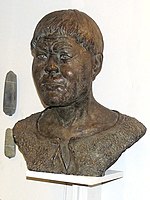 Hunter-gatherer populations, with their specific ancestries, between 14 ka and 9 ka. The area of the Eastern Hunter-Gatherer (EHG) appears in pink, with the site of Yuzhny Oleny (red circle) Hunter-gatherer populations, with their specific ancestries, between 14 ka and 9 ka. The area of the Eastern Hunter-Gatherer (EHG) appears in pink, with the site of Yuzhny Oleny (red circle) | |
 | |
| Location | Karelia, Russia |
|---|---|
| Coordinates | 62°03′00″N 35°21′30″E / 62.050022°N 35.358273°E / 62.050022; 35.358273 |
| Type | Burial site |
| History | |
| Periods | Late Upper Paleolithic to Mesolithic |

Yuzhny Oleny ("Southern Reindeer"), also Yuzhniy Oleniy, is an archaeological site located on Yuzhny Oleny island (Russian: Южный Олений остров, romanized: Yuzhniy Oleniy ostrov), in Lake Onega, Karelia.
Remains of Eastern Hunter-Gatherers dated to circa 8,100 BP (6,100 BCE) have been excavated at Yuzhny Oleny. A total of 19 Eastern Hunter-Gatherer genomes were extracted from Yuzhny Oleny, which had comparable or lower WHG ancestry compared to other EHG groups. The Ancient North Eurasian (ANE) ancestry is the main component of the Yuzhny Oleny group, and is particularly high among them compared to the rest of the Eastern Hunter-Gatherers (EHG). The 11 ka Sidelkino individual from Samara in western Russia also had a virtually identical profile with the members of the Yuzhniy Oleniy group. The genes of the Yuzhny Oleni were transmitted to the people of the Yamnaya Culture, and to Scandinavia through a western route.
A genetic study published in Nature in March 2023 examined the remains of fifteen individuals discovered in a burial site at Yuzhny Oleny, dating back to approximately 8,200 years ago. The nine samples of Y-DNA extracted belonged to haplogroup Q1a1-F746/NWT01 (three samples), Q1b1-L53, R1a2-YP4141, R1a-M420, R1-M173, and J1-L255 (two samples). The fifteen samples of mtDNA extracted belonged to haplogroup U4 (three samples), U2e1 (three samples), U5a1 (two samples), and R1b (three samples), U4a2, U2e1e, U5a2, and U5a2d.
The Eastern Hunter-Gatherer people established themselves in Karelia soon after the retreat of the ice sheet, circa 10,000 years before present (BP). The first implements were made of stone, but ceramics were introduced circa 5,000 BCE.
-
 Reconstruction of burial No. 132 of the Oleneostrovsky burial ground (Yuzhni Oleny island, Lake Onega). Exhibit of the National Museum of the Republic of Karelia.
Reconstruction of burial No. 132 of the Oleneostrovsky burial ground (Yuzhni Oleny island, Lake Onega). Exhibit of the National Museum of the Republic of Karelia.
-
Artifacts and reconstruction of the deceased (by Gerasimov) in tomb No. 132 from Yuzhni Oleny island.
-
 Forensic reconstruction by Gerasimov of individual in tomb No. 132 in Yuzhi Oleny island
Forensic reconstruction by Gerasimov of individual in tomb No. 132 in Yuzhi Oleny island
References
- Schulting, Rick J.; Mannermaa, Kristiina; Tarasov, Pavel E. (27 January 2022). "Radiocarbon dating from Yuzhniy Oleniy Ostrov cemetery reveals complex human responses to socio-ecological stress during the 8.2 ka cooling event". Nature Ecology & Evolution. 6 (2): 155–162. Bibcode:2022NatEE...6..155S. doi:10.1038/s41559-021-01628-4. ISSN 2397-334X. PMID 35087215. S2CID 246359996.
- Mittnik, Alissa; Wang, Chuan-Chao; Pfrengle, Saskia (30 January 2018). "The genetic prehistory of the Baltic Sea region". Nature Communications. 9 (1): Fig. 1. Bibcode:2018NatCo...9..442M. doi:10.1038/s41467-018-02825-9. ISSN 2041-1723. PMC 5789860. PMID 29382937. S2CID 256644735.
- ^ Posth, Cosimo; Yu, He; Ghalichi, Ayshin (March 2023). "Palaeogenomics of Upper Palaeolithic to Neolithic European hunter-gatherers". Nature. 615 (7950): 117–126. Bibcode:2023Natur.615..117P. doi:10.1038/s41586-023-05726-0. ISSN 1476-4687. PMC 9977688. PMID 36859578.
F4-statistics also show that the approximately 8.2 ka Yuzhniy Oleniy Ostrov group from Karelia in western Russia formed by 19 genomes has comparable or lower affinity to Villabruna ancestry than all the other EHG groups (Supplementary Data 2.K). The oldest individual revealing an indistinguishable genetic profile from the Yuzhniy Oleniy Ostrov group is the 11 ka Sidelkino individual from Samara in western Russia
- ^ Kozintsev, A. G. (4 January 2022). "Patterns in the Population History of Northern Eurasia from the Mesolithic to the Early Bronze Age, Based on Craniometry and Genetics". Archaeology, Ethnology & Anthropology of Eurasia. 49 (4): 141. doi:10.17746/1563-0110.2021.49.4.140-151.
ANE makes up the principal share of the EHG (Eastern Hunter-Gatherer) autosomal component, whose content is especially high in the genomes of Mesolithic and Early Neolithic inhabitants of northeastern Europe buried at Yuzhny Oleny Ostrov, Popovo, Sidelkino, Lebyazhinka IV, etc. (Haak et al., 2015; Damgaard et al., 2018). They passed EHG on to the Yamnaya people, from whom it was inherited by several fi lial populations, including Afanasyevans. As early as the Mesolithic, EHG was introduced from northern Russia to Scandinavia, as evidenced by genomes of the Motala people in southern Sweden. Their ancestors had migrated there from the east along the coast of Norway, because the share of EHG in more southern populations, such as the earlier Kunda people of the eastern Baltic, is lower (Haak et al., 2015; Mittnik et al., 2018).
- Posth et al. 2023, Supplementary Data 1.A.
- ^ National museum of Karelia, notice
- ^ Kozintsev, Alexander (1 January 2021). "Patterns in the population history of Northern Eurasia from the Mesolithic to the Early Bronze Age". Archaeology, Ethnology and Anthropology of Eurasia. 49 (4): 140–151. doi:10.17746/1563-0110.2021.49.4.140-151.
ANE makes up the principal share of the EHG (Eastern Hunter-Gatherer) autosomal component, whose content is especially high in the genomes of Mesolithic and Early Neolithic inhabitants of northeastern Europe buried at Yuzhny Oleny Ostrov, Popovo, Sidelkino, Lebyazhinka IV, etc. (Haak et al., 2015; Damgaard et al., 2018).", "Mesolithic, northern Russian Plain, Yuzhny Oleny Ostrov (Alekseyev, Gokhman, 1984)